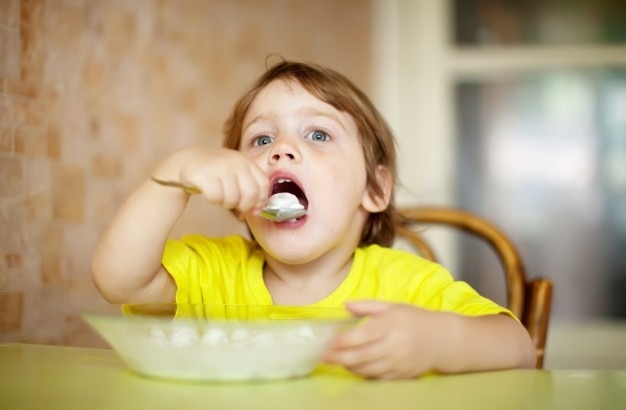
Recommended Meal Portions For Children 2 to 5 Years of Age
23 Feb 2018 | 5 min Read
Babychakra
Author | 1369 Articles
The healthy portion plate is the easiest way for new parents to ensure that their toddler is eating adequate nutrients each day.
The ‘healthy portion plate’ is a method that encourages eating the right amount of food, in the right quantities to promote health. The healthy portion plate for children aged 2-5 years includes an optimum combination of items from different food groups to ensure that the nutritional needs of your growing child are met. The various food groups include whole grains and cereals, fresh vegetables, fruits, dairy products, and oils.
What kind of proteins should a 2-to-5 year-old kid’s portion plate include and how much?

Toddler portion plates should include a total of 2 to 4 ounces of protein every day divided into two servings (to be increased to three portions for a vegetarian diet). 1 ounce portion is equal to any of the following: 1 oz. cooked meat, poultry, or fish, 1 cooked egg, 1 tablespoon peanut butter, 2-3 tbsp pulses, or 1⁄4 cup cooked beans.
Dairy foods in a growing kid’s portion plate

Two-to-three servings of dairy products should be included in the child’s daily diet, where one serving is equivalent to: 1 cup milk or yogurt, 5-7 tbsp custard, or 2 oz. processed cheese .
What quantity of whole grains should be included in a kid’s portion plate and what should it include?

A healthy portion of grains for a 2-5 years kid is approximately a total of 3 to 5 oz per day divided into three servings. One ounce of grains includes either 1 slice of bread, or 1 ⁄2 cup of cooked cereal, oatmeal, rice, or pasta. Alternative options include 1 cup dry cereal, 5 to 6 whole grain crackers, one 4-inch waffle or pancake, one 6-inch tortilla, or 1 ⁄2 hamburger bun, or a single 3-inch bagel.
What portion plate sizes of vegetables should be included in a kid’s portion plate ?

A healthy portion size for a 2-5 year-old kid should include a total of at least 1 to 1.5 cups of vegetables every day, divided into multiple servings. Since these are highly nutritious, larger portions can be consumed if the child wishes so. 1 cup equals: 1 cup cooked or raw vegetables, or 2 cups of leafy vegetables.
How much oil should be used for preparing meals for a child?

It should be noted that solid fats like butter, regular margarine, shortening, and lard, as well as foods that contain these ingredients should be limited in a kid 2-5 years of age. This is because a child has lesser energy requirements and does not need high amounts of fat.
Portion size plate of oil for a 2-5 year old kid should include a total of 3 to 4 teaspoons of the healthier options every day. One teaspoon (5 grams) oil equals: 1 teaspoon liquid vegetable oil, 1 tablespoon light mayonnaise, 2 tablespoons light salad dressing, or 1 teaspoon of margarine with zero trans-fat.
What portion plate sizes of fruits should be included kid’s portion plate?

1 to 1.5 cups of fruit daily constitutes a healthy portion size of fruit for a 2-5 year old kid. 1⁄2 cup equals: 1 ⁄2 cup chopped, cooked, or canned fruit , 1⁄4 cup dried fruit or 1 ⁄2 cup 100% fruit juice.
It should be noted that fruit juice should be limited to 4 oz. (1 ⁄2 cup) per day for children 1 to 3 years of age. For older children, 4 to 6 oz. of fruit juice per day can be given.
Some important considerations:
- Ensure that the child has meals and snacks at regular times each day.
- Salt should be limited and given in very low quantity to a child to stay healthy. The daily consumption of sodium should be limited to 800-1,000 milligrams for 1 to 3 year olds, and for 4 to 8 year olds, it should be less than 1,200 milligrams. By choosing foods with less sodium content, you can limit its intake.
- Half of the portion size plate should include fruits and vegetables, and the other half should be made up of be grains (whole grains).
- Oversized portions should be avoided.
- Water should be preferred over sugary drinks. Tea, coffee, and sugary drinks should be avoided.
- Eating or drinking between planned mealtimes and snack times should be limited.
- Allow enough time for children to eat as they can be slow eaters.
- In case of suspected allergies to any particular food, consult a doctor.
Disclaimer: The information in the article is not intended or implied to be a substitute for professional medical advice, diagnosis or treatment. Always seek the advice of your doctor.
Also read: Why You Should Add Ragi To Your Baby’s Diet
Explore the entire collection of articles: Baby Foods
A


Related Topics for you
Suggestions offered by doctors on BabyChakra are of advisory nature i.e., for educational and informational purposes only. Content posted on, created for, or compiled by BabyChakra is not intended or designed to replace your doctor's independent judgment about any symptom, condition, or the appropriateness or risks of a procedure or treatment for a given person.
